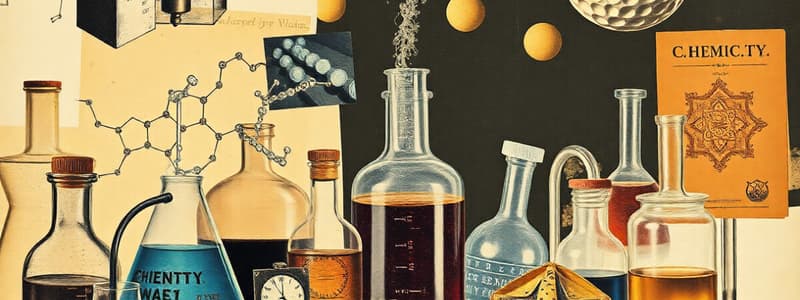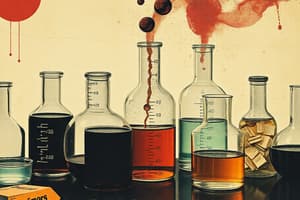Podcast
Questions and Answers
Just, want een verbinding is een stof waarbij de moleculen uit meer dan één atoomsoort bestaan.
Just, want een verbinding is een stof waarbij de moleculen uit meer dan één atoomsoort bestaan.
- juist
- juist, want een zuivere stof kan ook bestaan uit één soort moleculen en één molecuul kan uit verschillende soorten atomen bestaan.
- onjuist
- juist, want alleen een element bestaat uit één atoomsoort. (correct)
Elementen zijn: goud, zilver, zuurstof en ijzer. Verbindingen zijn: water, natriumchloride, aluminiumoxide, hout en suiker.
Elementen zijn: goud, zilver, zuurstof en ijzer. Verbindingen zijn: water, natriumchloride, aluminiumoxide, hout en suiker.
- onjuist (correct)
- onjuist (correct)
- juist
- onjuist (correct)
Cola is een mengsel en bestaat uit verschillende moleculen zoals watermoleculen, koolstofdioxidemoleculen, enzovoort. Er bestaan dus geen colamolenculen.
Cola is een mengsel en bestaat uit verschillende moleculen zoals watermoleculen, koolstofdioxidemoleculen, enzovoort. Er bestaan dus geen colamolenculen.
- onjuist
- onjuist
- onjuist
- juist (correct)
Een mengsel bestaat uit verschillende soorten deeltjes. Bij een zuivere stof zijn alle deeltjes gelijk.
Een mengsel bestaat uit verschillende soorten deeltjes. Bij een zuivere stof zijn alle deeltjes gelijk.
Zie figuur 1.1a.
Zie figuur 1.1a.
6 zuivere stof (Vlak bij de pakken suiker die je in een winkel koopt een kleine hoeveelheid van een stof smeltmengsel en een kookvloeistof. Zorg dat de suiker niet gaat plakken.)
6 zuivere stof (Vlak bij de pakken suiker die je in een winkel koopt een kleine hoeveelheid van een stof smeltmengsel en een kookvloeistof. Zorg dat de suiker niet gaat plakken.)
Olie mengt niet met water. Ether is hydrofoob.
Olie mengt niet met water. Ether is hydrofoob.
Alle stomen zitten door elkaar, dus er is sprake van een oplossing. Het mengsel is niet doorzichtig omdat zilver al klaar is in tegenstelling tot water. Ook doorzichtig is niet doorzichtig omdat zilver al klaar is in water.
Alle stomen zitten door elkaar, dus er is sprake van een oplossing. Het mengsel is niet doorzichtig omdat zilver al klaar is in tegenstelling tot water. Ook doorzichtig is niet doorzichtig omdat zilver al klaar is in water.
De totale verhouding is 20:1. Het percentage chroom is $\frac{3}{20}\times 100 = 15$%.
De totale verhouding is 20:1. Het percentage chroom is $\frac{3}{20}\times 100 = 15$%.
Met kruisproducten vind je dat het massapercentage $\frac{3\times 100}{20} = 15$% is.
Met kruisproducten vind je dat het massapercentage $\frac{3\times 100}{20} = 15$% is.
Een uitstekelijk mengsel smelt bij een lagere temperatuur dan samenstellende stoffen. Het heeft een specifieke samenstelling en een smeltpunt in plaats van een smeltstraject. Bij een smeltstraject verandert de temperatuur tijdens het smelten.
Een uitstekelijk mengsel smelt bij een lagere temperatuur dan samenstellende stoffen. Het heeft een specifieke samenstelling en een smeltpunt in plaats van een smeltstraject. Bij een smeltstraject verandert de temperatuur tijdens het smelten.
De daling voor menthol is $42 - 20 = 22^ heta C$ en voor kamfer $180 - 20 = 160^ heta C$.
De daling voor menthol is $42 - 20 = 22^ heta C$ en voor kamfer $180 - 20 = 160^ heta C$.
Destilleren en indampen
Destilleren en indampen
Verschil in destilleerbaarheid
Verschil in destilleerbaarheid
15 filtreren (bezinken)
15 filtreren (bezinken)
Een mengsel van vloeistoffen scheid je door middel van distillatie. De kookpunten moeten wel voldoende ver uit elkaar liggen.
Een mengsel van vloeistoffen scheid je door middel van distillatie. De kookpunten moeten wel voldoende ver uit elkaar liggen.
Stof A komt hoger in het chromatogram. Deze stof lost goed op en hecht minder, dus hij wordt beter door de loopvloeistof meegevoerd.
Stof A komt hoger in het chromatogram. Deze stof lost goed op en hecht minder, dus hij wordt beter door de loopvloeistof meegevoerd.
De oplosbaarheid in een andere loopvloeistof kan verschillen waardoor stof A nu misschien minder goed oplost dan stof B.
De oplosbaarheid in een andere loopvloeistof kan verschillen waardoor stof A nu misschien minder goed oplost dan stof B.
De smaaksstoffen en eventueel suiker in de kauwgom lossen op in het speeksel, de gom zelf niet. Er vindt dus scheiding plaats die berust op verschil in oplosbaarheid, extractie.
De smaaksstoffen en eventueel suiker in de kauwgom lossen op in het speeksel, de gom zelf niet. Er vindt dus scheiding plaats die berust op verschil in oplosbaarheid, extractie.
A. adsorptie
A. adsorptie
Het kookpunt van methanol is 333 K en dat van ethanol 351 K.
Het kookpunt van methanol is 333 K en dat van ethanol 351 K.
De membraanvliezen zijn de poriën van het filter veel kleiner, waardoor ook opgeloste stoffen allen vastgehouden. Bij gevulde deeltjes gaan opgeloste stoffen door het filter en worden alleen vaste stoffen gefiltreerd.
De membraanvliezen zijn de poriën van het filter veel kleiner, waardoor ook opgeloste stoffen allen vastgehouden. Bij gevulde deeltjes gaan opgeloste stoffen door het filter en worden alleen vaste stoffen gefiltreerd.
Extractie is alleen mogelijk als er een extractiemiddel is te vinden waarin één van beide stoffen oplost en de andere niet. Robert moet dus weten welk oplosmiddel voor de chemische stof van het mengsel mag worden gebruikt. Door gebruik van de juiste oplossing mag Robert zijn uit het mengsel halen. De koolstof blijft dan vanzelf over.
Extractie is alleen mogelijk als er een extractiemiddel is te vinden waarin één van beide stoffen oplost en de andere niet. Robert moet dus weten welk oplosmiddel voor de chemische stof van het mengsel mag worden gebruikt. Door gebruik van de juiste oplossing mag Robert zijn uit het mengsel halen. De koolstof blijft dan vanzelf over.
Begripsdefinitie en reactieproducten ontstaan.
Begripsdefinitie en reactieproducten ontstaan.
A pure substance consists of?
A pure substance consists of?
The ______ of a pure substance remains constant and doesn't change during heating and cooling.
The ______ of a pure substance remains constant and doesn't change during heating and cooling.
Which of the following is a mixture?
Which of the following is a mixture?
What is a solution?
What is a solution?
Which of the following solutions would you classify as a suspension?
Which of the following solutions would you classify as a suspension?
A substance can be identified by which of the following characteristics?
A substance can be identified by which of the following characteristics?
Which of the following describes a process where the temperature of a substance remains constant while energy is added?
Which of the following describes a process where the temperature of a substance remains constant while energy is added?
In a chemical reaction, the substances that react are called ______ and the substances that are formed are called ______ .
In a chemical reaction, the substances that react are called ______ and the substances that are formed are called ______ .
Which of the following is a common type of chemical reaction?
Which of the following is a common type of chemical reaction?
Energy is released in an exothermic reaction.
Energy is released in an exothermic reaction.
Energy must be added for an endothermic reaction to occur.
Energy must be added for an endothermic reaction to occur.
The minimum amount of energy needed to start a reaction is called the?
The minimum amount of energy needed to start a reaction is called the?
A catalyst can _____ the rate of a chemical reaction.
A catalyst can _____ the rate of a chemical reaction.
Match the following symbols with their corresponding elements:
Match the following symbols with their corresponding elements:
Flashcards
Create flashcards
Create flashcards
To make cards with information for learning.
10 flashcards
10 flashcards
Creating a set of ten flashcards.
Term
Term
A key word or phrase in a flashcard.
Definition
Definition
Signup and view all the flashcards
Hint
Hint
Signup and view all the flashcards
Memory tip
Memory tip
Signup and view all the flashcards
Key concepts
Key concepts
Signup and view all the flashcards
Simple explanations
Simple explanations
Signup and view all the flashcards
Educational content
Educational content
Signup and view all the flashcards
Non-educational content
Non-educational content
Signup and view all the flashcards
Study Notes
Content of Textbook
- Textbook title: Chemie Overal
- Edition: 5th
- Level: 4 HAVO (Dutch Secondary Education)
- Publisher: Noordhoff Uitgevers
Table of Contents Summary
- 1. Scheiden en reageren: Covers pure substances, mixtures, and separation techniques. Includes discussion of reaction rates.
- 2. Bouwstenen van stoffen: Details the periodic table, ions, and calculations related to atomic masses and molar calculations.
- 3. Stoffen en reacties: Categorization of substances, properties of metals and salts, molecular substances, and calculations of reactions.
- 4. Moleculaire stoffen: Focuses on intermolecular forces like Vanderwaals forces and hydrogen bonding.
- 5. Zouten en zoutoplossingen: Details salt formulas, names, and properties. Includes reactions between ions in solution.
- 6. Koolstofchemie: Exploration of alkanes, alkenes, functional groups, and reactions. Includes specific naming conventions
- 7. Zuren: Covers the concept of pH, indicators, and the difference between strong and weak acids. Includes calculations related to molarity
Studying That Suits You
Use AI to generate personalized quizzes and flashcards to suit your learning preferences.




